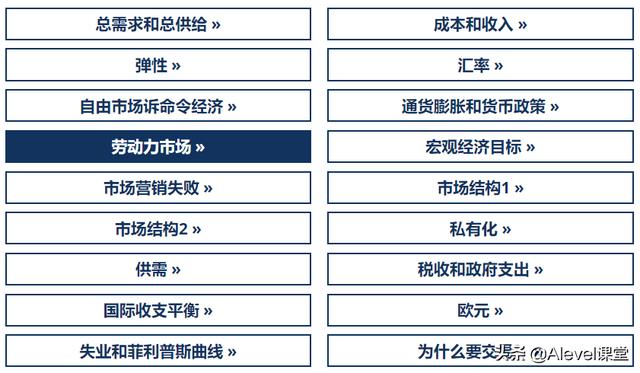中职国际商务教资面试(国际教育AlevelAP经济学学习笔记)

A-level economics revision guides and question banks covering labour markets, supply and demand, market structure and all core economics a-level topics.
以下内容我们会持续更新:

今天带给大家Alevel经济笔记是:
第七章:劳动力市场——完全竞争劳动力市场中的均衡工资
In the last two Learn-its, we looked at where the demand for labour and the supply of labour came from.
To find the equilibrium wage, as with the product market, we need to put these two concepts together.
For most industries, the equilibrium wage and quantity of labour employed will be determined where these two curves cross.
As we shall see, this is not necessarily the case for the monopsonist.
Let's start with the easy model of the perfectly competitive labour market.
在最后两个 Learn-it 中,我们研究了劳动力需求和劳动力供应的来源。要找到均衡工资,就像产品市场一样,我们需要将这两个概念放在一起。对于大多数行业,均衡工资和就业劳动力数量将在这两条曲线的交叉处确定。正如我们将看到的,垄断者不一定是这种情况。让我们从完全竞争劳动力市场的简单模型开始。
The equilibrium wage in a perfectly competitive labour market完全竞争劳动力市场中的均衡工资
The diagram below shows the equilibrium amount of labour employed, and the equilibrium wage, for the perfectly competitive industry and a firm in that industry.
下图显示了完全竞争行业和该行业公司的均衡就业劳动力数量和均衡工资。

We see the 'normal' looking demand and supply curves in the industry diagram on the left.
The curves cross at point A, giving real wage W1 and labour employed L1.
Remember that there are so many firms in the industry that each firm has no control over the given wage rate.
Each firm can employ as much labour as it wants at the given real wage rate W1.
The amount they actually employ depends on their MRP curve (which is their demand curve for labour).
As we said earlier, they will maximise their profit if they employ l1 units of labour where MRP = MFC (which occurs at point B).
我们在左侧的行业图中看到“正常”的供需曲线。曲线在 A 点相交,给出实际工资 W 1和就业劳动力 L 1。请记住,行业中有如此多的公司,以至于每家公司都无法控制给定的工资率。在给定的实际工资率 W 1下,每个企业都可以雇佣尽可能多的劳动力。他们实际使用的数量取决于他们的 MRP 曲线(这是他们的劳动力需求曲线)。正如我们之前所说,如果他们雇用 l 1个单位的劳动力,其中 MRP = MFC(发生在 B 点),他们将最大化他们的利润。
Shifts in the demand and supply curves 需求曲线和供给曲线的移动An important part of the topic 'Supply and demand' was the analysis of why the industry supply and demand curves might shift.
We must do the same here, but this time we are dealing with labour markets rather than product markets.
“供需”主题的一个重要部分是分析行业供需曲线为何会发生变化。我们必须在这里做同样的事情,但这次我们处理的是劳动力市场而不是产品市场。
Shifts in demand需求变化
Just like with the product market, the demand for labour curve will only shift if one of the conditions of demand changes.
It will not shift just because the real wage rate itself changes.
就像产品市场一样,只有当需求条件之一发生变化时,对劳动力的需求曲线才会移动。它不会仅仅因为实际工资率本身发生变化而发生变化。
Remember that the demand for labour curve is the MRP curve, which was, in turn, derived from the MPP curve.
If there is an improvement in labour productivity then this will mean that the workers will produce more at any given wage rate (and given the fixed amount of capital), and the MPP curve will shift to the right, shifting the MRP curve to the right.
请记住,劳动力需求曲线是 MRP 曲线,而 MRP 曲线又源自 MPP 曲线。如果劳动生产率有所提高,那么这将意味着在任何给定的工资率(以及给定的固定资本量)下,工人将生产更多,并且 MPP 曲线将向右移动,MRP 曲线将向右移动.
Also remember that the MRP curve was derived from the MPP times the price.
So, if the price of the good being produced changes, then this will change the MRP at all wage levels and the MRP curve will shift.
还要记住,MRP 曲线是从 MPP 乘以价格得出的。因此,如果所生产商品的价格发生变化,那么这将改变所有工资水平的 MRP,并且 MRP 曲线将会移动。
In a similar way to the product market, where the change in the price of a substitute can shift the demand curve, if the price of, say, capital rises (a substitute for labour), then the demand curve for labour will shift to the right.
与产品市场类似,替代品价格的变化可以移动需求曲线,如果资本价格上升(劳动力的替代品),那么劳动力的需求曲线将移动到正确的。

We can see how these shifts will affect the equilibrium wage and labour employed. The initial equilibrium is wage W1 and labour L1.
If, for example, there were an improvement in the productivity levels of the workers in an industry (more efficient use of labour through shift work perhaps), then the labour demand curve (MRP curve) would shift to the right, causing a rise in the real wage rate to W2 and a rise in numbers employed to L2.
我们可以看到这些变化将如何影响均衡工资和就业劳动力。初始均衡是工资 W 1和劳动力 L 1。例如,如果一个行业的工人的生产率水平有所提高(可能通过轮班工作更有效地利用劳动力),那么劳动力需求曲线(MRP 曲线)将向右移动,导致实际工资率增加到 W 2和就业人数增加到 L 2。
What if the price of the good being produced fell (due to a fall in real incomes and a shift to the left of the product demand curve perhaps)?
This would make the value of MRP fall for all wage levels, and so the labour demand curve would shift to the left, giving wage W3 and labour employed L3.
如果生产的商品价格下降(可能是由于实际收入下降和产品需求曲线向左移动)怎么办?这将使所有工资水平的 MRP 值下降,因此劳动力需求曲线将向左移动,从而得到工资 W 3和雇佣劳动力 L 3。
Shifts in supply供应变化
One of the reasons is fairly obvious; the other is a bit subtler.
The obvious one is if the is simply an increase in the number of people in the economy available to work in the given industry.
This could be because of an increase in net immigration, a change in the demographics of the economy or due to government policy, like the New Deal. These increases in numbers will shift the supply of labour curve to the right.
原因之一是相当明显的;另一个有点微妙。显而易见的是,如果这仅仅是经济中可在特定行业工作的人数的增加。这可能是因为净移民的增加、经济人口结构的变化或政府政策(如新政)。这些数量的增加将使劳动力供给曲线向右移动。
A less obvious cause is the situation in other industries.
If, in relative terms, the wage rate becomes less attractive in a similar industry, or the working conditions deteriorate, then the industry in question will experience an increase in the number of workers offering their labour services. This will shift the supply of labour curve to the left.
一个不太明显的原因是其他行业的情况。如果相对而言,类似行业的工资率变得不那么有吸引力,或者工作条件恶化,那么相关行业提供劳务的工人数量将会增加。这将使劳动力供给曲线向左移动。

In the diagram above, you can see what happens to the equilibrium when the supply curve shifts. A shift to the right causes the real wage rate to fall (from W1 to W2) and the numbers employed to rise (from L1 to L2).
A shift to the left causes the real wage rate to rise (from W1 to W3) and the numbers employed to fall (from L1 to L3).
在上图中,您可以看到当供给曲线移动时均衡会发生什么。向右移动会导致实际工资率下降(从 W 1到 W 2)和就业人数上升(从 L 1到 L 2)。向左移动会导致实际工资率上升(从 W 1到 W 3)而就业人数下降(从 L 1到 L 3)。
The equilibrium wage in monopsony垄断企业的均衡工资
Before we get going, it should be noted that labour markets might be imperfect due to there being only one seller of labour as well as the case covered here, the monopsonist buyer of labour (one buyer of labour - the employer).
The best example of a situation where there is only one seller of labour is where a trade union manages to control the amount of labour available to the employer.
This special case is covered in the Learn-it called 'Trade unions'.
在我们开始之前,应该注意劳动力市场可能是不完善的,因为只有一个劳动力卖方以及这里所涵盖的情况,即劳动力的垄断买方(劳动力的一个买方 - 雇主)。只有一个劳动力卖方的情况的最好例子是工会设法控制雇主可用的劳动力数量。这种特殊情况包含在称为“工会”的 Learn-it 中。

Look at the diagram above. You should recognise the supply curve and the MFC curve, which is above the supply curve.
Remember that the marginal cost of employing an extra worker for the monopsonist is much higher than the actual wage offered (which is read off the supply curve).
In attracting the extra worker, the slight rise in the real wage rate has to be paid to all the existing workers, on top of the wage that is paid to the new worker.
看上面的图表。你应该认识供给曲线和高于供给曲线的 MFC 曲线。请记住,为垄断者雇用额外工人的边际成本远高于提供的实际工资(从供给曲线中读取)。为了吸引额外的工人,除了支付给新工人的工资之外,还必须支付给所有现有工人的实际工资率的小幅上涨。
The demand curve has been added. Ignoring the MFC curve for the minute, where would the equilibrium be if this labour market were perfectly competitive?
Where the supply and demand curves cross (point C), giving a wage of W2 and employment L2.
添加了需求曲线。暂时忽略 MFC 曲线,如果这个劳动力市场完全竞争,均衡会在哪里?在供给曲线和需求曲线相交的地方(C 点),工资为 W 2,就业为 L 2。
Now consider the monopsonist. He will maximise profit at the point where MRP = MFC (just like MC = MR in the product market).
This occurs at point A, but the real wage rate will not be W3. The real wage rate is read off the supply curve (of average factor cost curve), giving W1.
Do you remember that we said earlier that this diagram is the reflection of the monopolist's product market diagram? If you think about it, the point where MC = MR on the product diagram is below the demand curve from which the price is obtained.
The same is going on here but upside down!
The point where MRP = MFC on the labour diagram is above the supply curve from which the wage is obtained.
The two sentences are the same except for the bits in italics.
现在考虑垄断者。他将在 MRP = MFC(就像产品市场中的 MC = MR)处最大化利润。这发生在 A 点,但实际工资率不会是 W 3。实际工资率是从供给曲线(平均要素成本曲线)中读出的,给出 W 1。还记得我们之前说的这个图是垄断者产品市场图的反映吗?如果您考虑一下,产品图上MC = MR的点位于获得价格的需求曲线下方。这里也发生了同样的事情,但颠倒了!劳动图上MRP = MFC的点位于供给曲线上方从中获得工资。除了斜体字外,这两个句子是相同的。
The implication of all this is that the monopsonist pays a lower wage (W1 < W2) and employs fewer workers (L1 < L2) than if the industry had a perfectly competitive labour market.
Also, the monopsonist is paying its workers at a rate that is below their marginal revenue products.
In other words, it is paying them less than they are worth to the monopsonist.
The distance AB is the difference between what the last worker earned for the monopsonist in terms of revenue (the MRP) and what he was actually paid (W1).
The workers are being exploited!
所有这一切的含义是,与行业有完全竞争的劳动力市场相比,垄断者支付的工资更低(W 1 < W 2)并且雇用的工人更少(L 1 < L 2 )。此外,垄断者以低于其边际收益产品的比率支付工人工资。换句话说,它支付给他们的报酬低于垄断者的价值。距离 AB 是最后一个工人为垄断者赚取的收入(MRP)与他实际得到的报酬(W 1)之间的差值。工人被剥削!
Transfer earnings and economic rent转移收益和经济租金
These are two important concepts, which, in a sense, are quite similar to the concepts of consumer surplus and producer surplus in the product market.
这是两个重要的概念,在某种意义上与产品市场中的消费者剩余和生产者剩余的概念非常相似。
Defined formally, transfer earnings are the minimum earnings required for a unit of labour to stay in its present use.
Economic rent refers to any earnings over and above a worker's transfer earnings.
The best way to explain these concepts is to use a diagram.
正式定义,转移收入是一单位劳动维持其当前用途所需的最低收入。经济租金是指超过工人转移收入的任何收入。解释这些概念的最好方法是使用图表。

In the diagram above, you can see the 'normal' looking demand and supply curves.
The equilibrium occurs at point A, giving a real wage rate of W2 and employment L2.
在上图中,您可以看到“正常”的供需曲线。均衡发生在 A 点,实际工资率为 W 2,就业率为 L 2。
The upward sloping supply curve implies that as the real wage rate rises, more and more workers are prepared to offer their labour services.
As the real wage rate reaches W1, the 50th worker is just prepared to work for that real wage rate.
W1, therefore, represents the minimum amount for which the 50th worker is prepared to work in this industry.
It is his transfer earnings.
If he earned any less he would transfer his labour services to 'another use' (a different job).
At the equilibrium wage W2, 100 workers are employed.
This means that the 100th worker was only just attracted into the industry.
Again, this is his transfer earnings.
向上倾斜的供给曲线意味着随着实际工资率的上升,越来越多的工人准备提供他们的劳务服务。当实际工资率达到 W 1时,第 50个工人刚刚准备为该实际工资率工作。因此,W 1代表第 50名工人准备在该行业工作的最低金额。这是他的转会收入。如果他挣得少了,他就会把他的劳务转移到“另一种用途”(不同的工作)。在均衡工资 W 2下,雇佣了 100 名工人。这意味着第 100 名工人只是刚刚被吸引到这个行业。再说一次,这是他的转移收益。
Given that the equilibrium wage is W2, the 50th worker is doing quite well.
He was prepared to work in this industry for W1, but he is being paid W2.
The extra that he is earning over and above W1 is his economic rent (represented by the distance CD, or W2 - W1).
假设均衡工资是 W 2,第 50个工人的工作做得很好。他准备为 W 1在这个行业工作,但他的报酬是 W 2。他在 W 1之外赚取的额外收入是他的经济租金(由距离 CD 或 W 2 - W 1表示)。
If we extend all of this analysis to all real wage rates, then total transfer earnings is represented by the green trapezium and total economic rent is represented by the blue triangle.
如果我们将所有这些分析扩展到所有实际工资率,则总转移收入由绿色梯形表示,总经济租金由蓝色三角形表示。
So what is the main determinant of transfer earnings and economic rent?
It should be clear from the diagram that the elasticity of the supply curve is crucial.
If the supply curve was very flat (elastic), then the blue triangle would be very small and the green trapezium would be very large.
The opposite would occur if the supply curve were very steep.
那么转会收益和经济租金的主要决定因素是什么?从图中可以清楚地看出,供给曲线的弹性至关重要。如果供给曲线非常平坦(有弹性),那么蓝色三角形会非常小,而绿色梯形会非常大。如果供给曲线非常陡峭,则会发生相反的情况。
今天的Alevel经济笔记就更新到这里,如果大家对Alevel经济学感兴趣可以关注我们,
关于Alevel经济笔记第7章:劳动力市场后续的更新计划如下:

免责声明:本文仅代表文章作者的个人观点,与本站无关。其原创性、真实性以及文中陈述文字和内容未经本站证实,对本文以及其中全部或者部分内容文字的真实性、完整性和原创性本站不作任何保证或承诺,请读者仅作参考,并自行核实相关内容。文章投诉邮箱:anhduc.ph@yahoo.com






